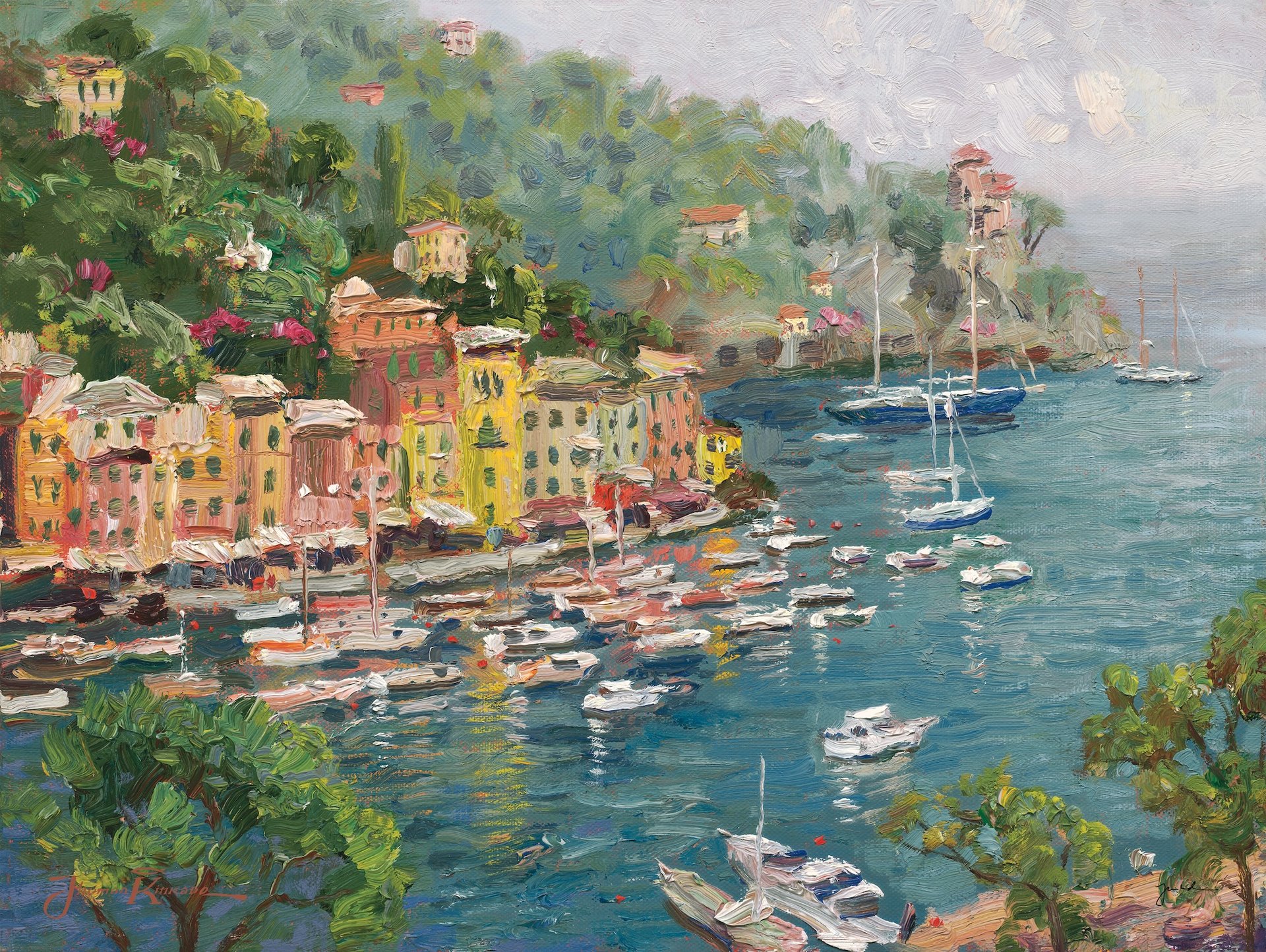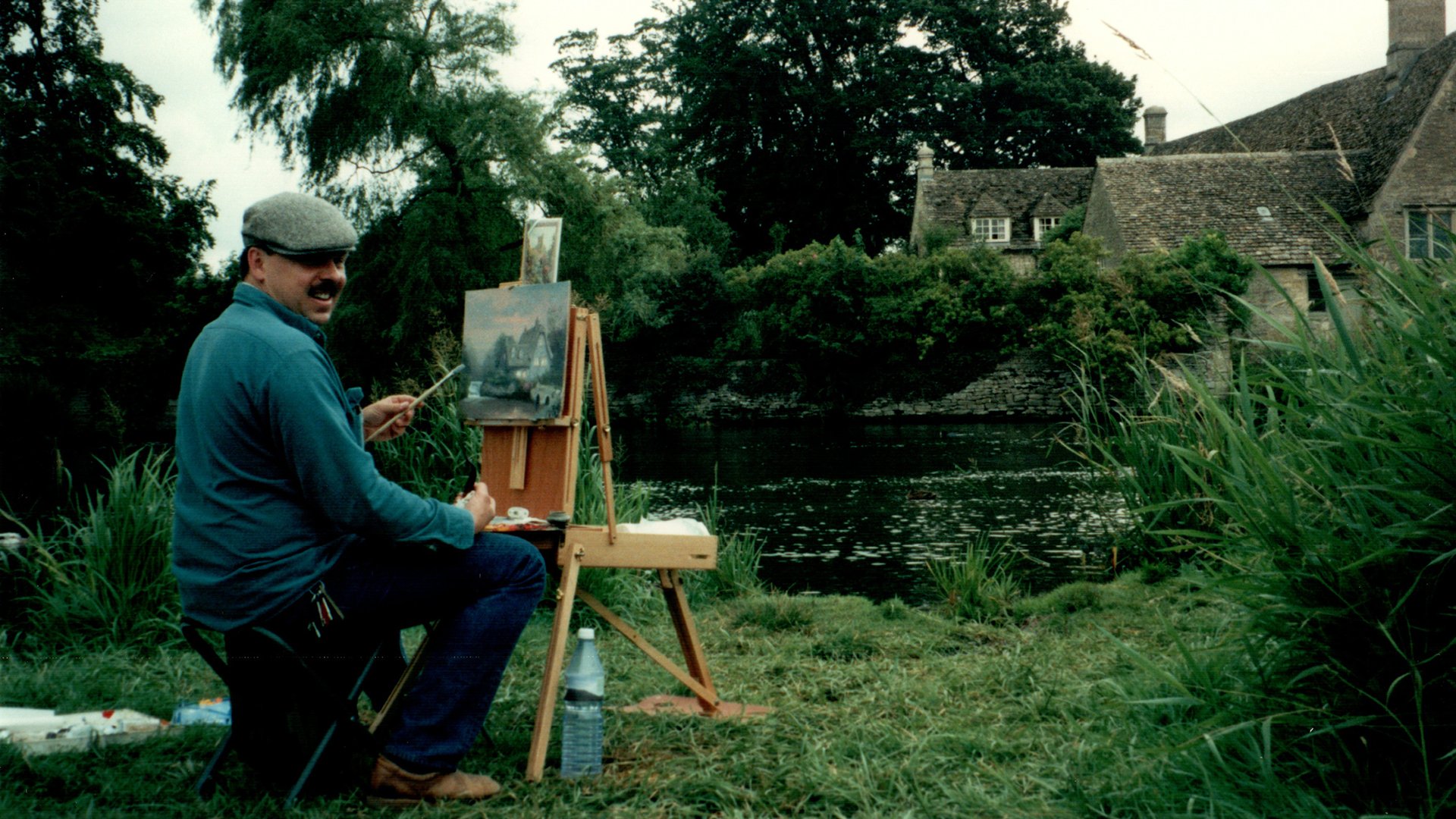“Thomas Kinkade had a fairly outsize cultural affect with actually unhealthy artwork,” says the Los Angeles Occasions artwork critic Christopher Knight in a brand new documentary movie in regards to the painter. “I imply, actually, actually, actually unhealthy artwork.”
The author Susan Orlean, who profiled the self-styled “painter of sunshine” for The New Yorker in 2001, has a barely extra nuanced take. “Thomas Kinkade was a efficiency artist,” she says, calling his pious Christian persona and multimillion-dollar empire of prints and souvenirs of every kind “maybe the best efficiency artwork piece we’ve seen in our lifetime”.
Identified for his schmaltzy photographs of cottages in verdant meadows overlooking effervescent brooks, Kinkade made works that had been ubiquitous within the US within the Nineteen Nineties. He was a favorite amongst evangelical Christians and suburban mothers, who lined as much as purchase his work, prints, commemorative plates, mouse pads, armchairs upholstered along with his landscapes and all method of different merchandise. At Kinkade’s top, one in 20 households within the nation owned one thing along with his branded imagery. He even opened a housing improvement of cottages impressed by his fictional landscapes. With each cheer and bravado, Kinkade himself was throughout magazines and tv hawking his wares. Procuring malls had complete shops devoted to his artwork and tchotchkes.
Little did the general public know that Kinkade had an entire vault of works that had nothing to do with cottages and flowery landscapes. Inside are 1000’s of darkish self-portraits, loving depictions of family and friends, Impressionist-style cityscapes, shadowy alleys, skies on fireplace and even surrealistic abstractions. When the film-maker Miranda Yousef exhibits the critics photographs of those items in direction of the top of the brand new documentary Artwork for All people, they’re shocked. Orlean is really delighted.
Thomas Kinkade’s Untitled (Self-portrait with a Paint Stained Shirt) (round 1979), from his college years, was discovered within the artist’s vault after his dying Picture: Jeff McLane, courtesy the Kinkade Household Basis
Whereas the query of what’s “good” and “unhealthy” artwork lingers within the background of the movie, Kinkade’s aesthetics take a backseat to answering the query of how we will be taught to see and empathise with folks in all their complexities. Why did Kinkade insist on portray sunshine and rainbows, hiding his true self in a cloak of saccharine nostalgia for one thing that by no means existed within the first place?
Yousef has a principle. She factors to “two holes in his coronary heart” that Kinkade would try to fill his complete life, to no avail. One was as a result of abject poverty of his childhood. The small home he grew up in was typically darkish, as his mom couldn’t afford to pay the electrical invoice; that is why he painted idyllic cottages with all of the lights on and labored tirelessly to make as a lot cash as attainable. The opposite was his should be liked by all—the results of an abusive and infrequently absent father.
However Kinkade didn’t begin out as an aspirational Norman Rockwell-Walt Disney hybrid. “I need to keep away from portray foolish and candy photos, charming photos, completely happy photos,” he says in an audio recording he made as a teen, when he was desirous about skipping school and shifting straight to New York Metropolis. “I need to paint the reality, and the reality of this world isn’t happiness. The reality of this world is ache, and that’s the one reality.”
Kinkade attended artwork college on the College of California, Berkeley, however he discovered it onerous to slot in—maybe partially due to his background. (He didn’t know what an actual hamburger was till he received there, Yousef says, as his mother would combine the meat with oatmeal at residence to save cash.) Kinkade had a psychological breakdown and dropped out, ending his research on the Artwork Heart School of Design in Pasadena. He grew to become an evangelical Christian across the similar time.
“He was actually well-educated about artwork and artwork historical past, which was shocking to me,” Yousef tells The Artwork Newspaper. “Earlier than the cottages, he was portray large-format westerns. He was extraordinarily influenced by the Hudson River Faculty.” She additionally notes that Kinkade was “actually good at matching types—his imitation of Norman Rockwell seems to be like an actual Norman Rockwell”.

Thomas Kinkade’s Portofino (2003), an Impressionist-style portray discovered within the vault Courtesy the Kinkade Household Basis
Yousef says she didn’t perceive “how skillful a painter Kinkade was” earlier than beginning the movie mission. She factors out that many different folks had been placing photographs of cottages on commemorative plates within the Nineteen Nineties, “however they had been horrible. His ability blew them out of the water. And now his model has change into the archetype.”
Kinkade was additionally prolific. He created a brand new intricately detailed cottage portray each month, along with working his empire of prints and collectibles. He was one of many first folks to make himself right into a model. “Andy Warhol would’ve revered his advertising genius,” Yousef says.
Warhol’s identify comes up typically within the documentary, and it’s no accident that two consultants on the Pop artist are interviewed within the movie—the previous Andy Warhol Museum director Eric Shiner and the critic and Warhol biographer Blake Gopnik. As Kinkade as soon as mentioned, “I’ve achieved the Nirvana that Andy Warhol dreamed of reaching. Warhol’s dream was that he would change into a robotic who simply might push a button and his work would come out with out him even being concerned, and I’ve achieved that!” The efficiency artist reveals himself. Even Kinkade’s circle of relatives calls him one.
Amazingly, the artist’s spouse, all 4 of his children and his two siblings participated within the movie, along with a few of his closest buddies and a few vibrant superfans. They offered not solely insightful interviews however archival photographs, residence motion pictures, packing containers of fan letters, Kinkade’s teenage audio recordings and the all-important entry to his vault. Yousef says that it was notably necessary for her to provide voice to his instant household, who had been typically overshadowed by Kinkade’s public persona and success.

Nonetheless from Artwork for All people, exhibiting Kinkade portray certainly one of his signature cottages en plein air
In direction of the start of the movie, every of Kinkade’s youngsters holds up a portray that their father made particularly for them in his conventional model. In a touching bookend, in direction of the top, they every select a favorite beforehand unknown work of his from the vault. “Virtually ten years after he died, the household was prepared to speak,” Yousef says. One in all his children, Windsor Kinkade, is now an artist.
Kinkade’s life started to spiral within the early 2000s. As soon as a teetotaller, he had change into an alcoholic. His consuming ultimately led to the implosion of his private {and professional} life. His spouse left with the children. He unscrupulously fired his enterprise companion, certainly one of his oldest and closest buddies. The enterprise crashed. There have been lawsuits in opposition to him and his firm. He died in 2012 of an overdose of alcohol and Valium. He was 54.
“His photographs killed him,” says the artwork historian and theologian Daniel A. Siedell in direction of the top of Artwork for All people, concluding that Kinkade’s bucolic scenes had been oppressive, leaving no room for grace or redemption. Artwork critics had lengthy seen Kinkade’s work as pernicious and unsettling, however maybe they’d not thought of how this affected the artist himself in his quest to thumb his nostril on the “respectable” artwork world and create what he noticed as a extra accessible artwork for the frequent man.
“The one factor I would like folks to remove from the movie is the significance of treating others with compassion and nuance,” Yousef says. “We’re all advanced folks, and we completely should rehumanise one another. It’s the one means we will transfer ahead as a society.”
Watch the trailer for Artwork for All people:
Artwork for All people has upcoming screenings at theatres in New York Metropolis, Santa Fe, Chicago, Los Angeles and elsewhere









